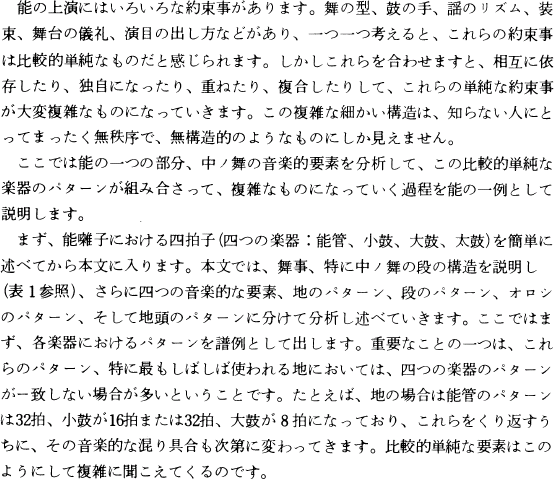No CrossRef data available.
Published online by Cambridge University Press: 07 March 2019
No is a classical Japanese dramatic form whose origins date from before 1400 A.D. Combining the elements of dance movement, music and drama with the visual elements of costumes, masks, and staging, it has a number of strict rules and conventions that are followed in its presentation. Individually, these rules and conventions are not particularly difficult to understand or execute—or at least they appear quite simple. In fact, however, the energy and concentration put into these seemingly simple movements and patterns, along with their vast numbers, interlocking and overlapping, interdependent and independent, can make the entire performance quite complex.

1. These include the chû-no-mai (“medium dance”), jo-no-mai (a slower dance), shin-no-jo-no-mai (a slow “god dance”), otoko-mai (a fast “male dance”), hayamai (a high-pitched “fast dance”), kami-mai (a very quick “god dance”), gaku (a court dance) and kagura (a shrine dance).Google Scholar
2. This structure is based on the dance versions of the Kanze and Hôsho main actor schools of Nô. The three other main actor schools, Kita, Komparu and Kongo, actually have a sixth division in their five-dan structure. It is still called a five-dan structure nonetheless because they count the “dividing points” rather than the “divisions.”Google Scholar
All maigoto are most commonly performed in an abbreviated three-dan version, except for gaku and kagura which have more complex flute melodic structures. The abbreviated three-dan version is the same as the five-dan structure shown here, only minus the third division. This holds true for all main-actor schools. Thus, for the three-dan structure, the term dan also refers to the number of “dividing points” rather than “divisions.”Google Scholar
3. I will base my explanations of the patterns of the four instruments on the following four schools: the Issô school of nôkan; the Kô school of kotsuzumi; the Takayasu school of ôtsuzumi; and the Komparu school of taiko. Other schools for each of the instruments have slightly different patterns and/or names of patterns. However, particularly with regard to maigoto, the overall basic structure of the whole dance as well as that of the individual patterns is the same, regardless of school.Google Scholar
4. The taiko is used in only about half of the plays of the Nô repertoire. Of pieces having maigoto instrumental dances, the taiko is always used with the shin-no-jo-no-mai pieces, hayamai pieces, kami-mai pieces and kagura pieces. It is never used with otoko-mai pieces. Pieces using the other three maigoto, including chû-no-mai pieces, are played both with and without the taiko. In such pieces, the patterns of the kotsuzumi and ôtsuzumi vary slightly between playing with and playing without the taiko. These variations occur only at the dan.Google Scholar